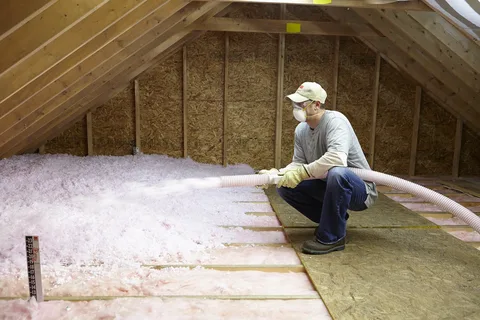
The conventional wisdom surrounding home insulation often overlooks ingenious solutions hiding in plain sight. While traditional methods focus on expensive retrofits and professional installations, resourceful homeowners have discovered remarkable techniques that deliver impressive results using readily available materials and creative thinking. These proven strategies challenge industry assumptions while providing tangible benefits that show up immediately on energy bills.
The Science Behind Unexpected Thermal Barriers
Understanding heat transfer principles unlocks countless opportunities for innovative insulation solutions. Heat moves through conduction, convection, and radiation, and each pathway offers unique intervention points that don't require construction expertise or significant investment.
Air remains the most effective insulating material when properly contained. This fundamental principle explains why many successful hacks focus on creating dead air spaces rather than adding expensive materials. Trapped air pockets provide exceptional thermal resistance, often outperforming costly commercial products when strategically implemented.
Reflective surfaces can redirect radiant heat with stunning efficiency. Aluminum foil, reflective emergency blankets, and even strategically placed mirrors can significantly impact thermal dynamics. The key lies in understanding how radiant energy behaves and positioning reflective materials to interrupt unwanted heat transfer.
Thermal bridging represents a major weakness in most homes, where conductive materials create pathways for heat loss. Identifying and interrupting these bridges often yields dramatic improvements with minimal effort. Metal window frames, concrete slabs, and structural elements frequently become thermal highways that simple interventions can effectively block.
Everyday Materials as Thermal Game-Changers
Bubble wrap emerges as one of the most underrated insulation materials available. When applied to windows, it creates an effective double-glazing effect while maintaining transparency. The air pockets within bubble wrap provide excellent thermal resistance, reducing heat loss by up to thirty percent. Large bubble varieties perform better than small ones, creating more substantial air chambers.
Newspaper transforms into surprisingly effective insulation when properly utilized. Crumpled newspaper creates countless air pockets while providing reasonable thermal resistance. This technique proves particularly valuable for temporary insulation needs or areas where conventional materials prove impractical. The key involves creating loose, airy masses rather than compressed layers.
Pool noodles offer unexpected versatility for sealing thermal gaps. Their flexibility allows conforming to irregular shapes while their closed-cell foam construction provides decent insulation properties. They excel at sealing around pipes, irregular openings, and temporary applications where removable solutions prove necessary.
Draft stoppers fashioned from rice-filled socks create highly effective door and window seals. Rice conforms to irregular surfaces while providing thermal mass that helps stabilize temperature fluctuations. These simple devices often outperform commercial alternatives while costing virtually nothing to produce.
Window Wizardry for Maximum Thermal Control
Windows represent the weakest thermal links in most homes, but clever interventions can dramatically improve their performance without replacement. Removable window films create additional air layers while maintaining visibility and natural light access. These films work best when installed with small air gaps, creating insulating chambers.
Thermal curtains constructed from emergency blankets provide exceptional performance at minimal cost. The reflective surface redirects radiant heat while the multiple layers create dead air spaces. These curtains can be easily removed during warmer months, providing seasonal flexibility that commercial alternatives rarely match.
Magnetic window seals using weatherstrip magnets create removable thermal barriers for metal window frames. This technique allows seasonal adjustments while providing excellent sealing performance. The magnetic connection ensures consistent contact pressure without permanent modifications.
 Interior storm windows fashioned from clear plastic sheeting and magnetic strips offer professional-level performance at fraction of commercial costs. These temporary installations can reduce heat loss by up to fifty percent while remaining completely removable. The key involves creating taut surfaces with adequate air gaps for maximum thermal performance.
Interior storm windows fashioned from clear plastic sheeting and magnetic strips offer professional-level performance at fraction of commercial costs. These temporary installations can reduce heat loss by up to fifty percent while remaining completely removable. The key involves creating taut surfaces with adequate air gaps for maximum thermal performance.
Attic and Crawlspace Innovations
Reflective barriers in attics can redirect summer heat while allowing winter heat retention through strategic positioning. Radiant barriers work best when facing air spaces, reflecting heat rather than absorbing it. Proper installation involves maintaining air gaps and ensuring reflective surfaces remain clean and unobstructed.
Crawlspace insulation using recycled materials often outperforms expensive alternatives. Old blankets, sleeping bags, and winter clothing can provide excellent thermal barriers when properly installed. The key involves protecting these materials from moisture while ensuring adequate ventilation to prevent condensation issues.
Attic stair insulation using rigid foam boards creates removable barriers that dramatically reduce heat loss through access points. These covers can incorporate handles and weather sealing for professional performance while remaining easily removable for access needs.
Floor insulation using area rugs and carpet padding provides immediate thermal improvement while adding comfort and noise reduction. Strategic placement of thermal barriers between living spaces and unconditioned areas can significantly impact overall home comfort levels.
Basement and Foundation Thermal Strategies
Foundation walls often represent major thermal losses that simple interventions can address effectively. Rigid foam board attached with construction adhesive provides excellent thermal barriers while remaining moisture-resistant. This technique works particularly well on concrete foundations where traditional insulation proves challenging.
Basement ceiling insulation using suspended thermal barriers can dramatically reduce heat loss to unconditioned spaces. These barriers work best when they create continuous thermal breaks while allowing access for maintenance needs. Removable sections ensure accessibility without compromising thermal performance.
Sill plate sealing using expanding foam or caulk addresses often-overlooked thermal bridges. These areas frequently allow significant air infiltration while remaining hidden from casual observation. Proper sealing of these gaps often provides dramatic comfort improvements with minimal effort.
Basement window wells benefit from temporary insulation during heating seasons. Clear plastic covers or removable insulation panels can significantly reduce heat loss while maintaining emergency egress capabilities. These solutions work best when they incorporate ventilation to prevent condensation issues.
Advanced Heat Recovery and Distribution
Thermal mass strategies using water containers can help stabilize temperature fluctuations while storing solar heat during sunny periods. Strategic placement of water-filled containers near south-facing windows can provide passive heating benefits while moderating temperature swings.
Heat distribution improvements using fans and ducting can balance temperatures throughout homes without expensive HVAC modifications. Simple fan installations can move warm air from sunny areas to cooler zones, improving overall comfort while reducing heating demands.
Cast Iron Radiator systems benefit tremendously from reflective panels placed behind them, redirecting heat into living spaces rather than warming exterior walls. These panels can be fashioned from emergency blankets or aluminum-faced insulation, dramatically improving heating efficiency. The thermal mass of cast iron heating elements makes this hack particularly effective, as the reflected heat compounds the natural radiant heating properties.
Seasonal Adaptation and Maintenance
Insulation strategies must adapt to changing seasonal needs while remaining practical for long-term use. Removable solutions provide flexibility while permanent improvements offer consistent benefits. The key involves balancing immediate needs with long-term performance goals.
Monitoring effectiveness through energy bill analysis helps identify successful techniques while revealing areas needing attention. Simple temperature measurements can provide objective feedback about thermal improvements, guiding future enhancement efforts.
Conclusion
Effective insulation extends far beyond expensive commercial products and professional installations. Creative application of everyday materials, combined with understanding of thermal principles, can deliver remarkable results that rival conventional solutions. These proven hacks demonstrate that thermal comfort and energy efficiency remain accessible to anyone willing to think creatively and apply basic principles consistently.
The most successful approaches combine multiple techniques while adapting to specific home characteristics and seasonal needs. Regular experimentation and monitoring ensure continued improvement while building confidence in alternative approaches. These methods prove that effective insulation relies more on understanding thermal dynamics than expensive materials, opening possibilities for significant energy savings through intelligent application of simple solutions.
0 comments
Be the first to comment!
This post is waiting for your feedback.
Share your thoughts and join the conversation.
